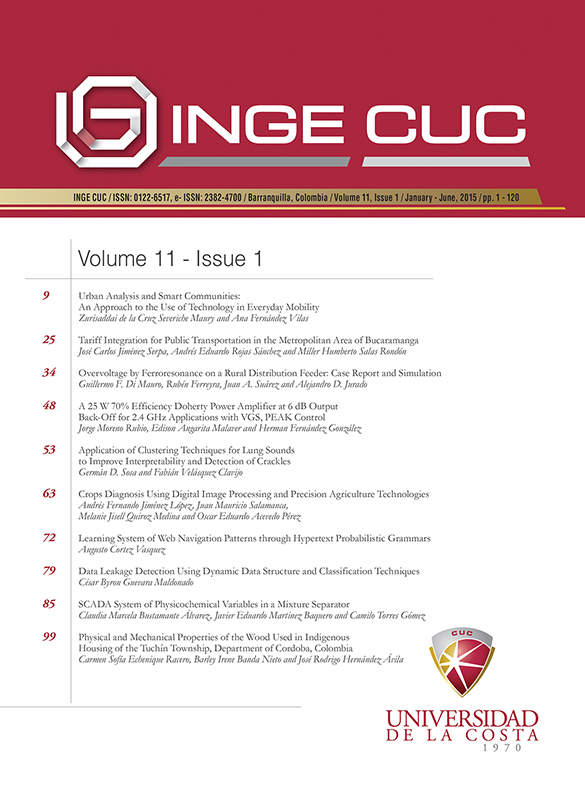Integración Tarifaria para el Transporte Público del Área Metropolitana de Bucaramanga
Palabras clave:
Transporte público, Integración tarifaria, Accesibilidad, Calidad del servicio, Sistema masivoResumen
La implementación de un sistema de transporte público masivo paralelo al convencional no es garantía suficiente para satisfacer las necesidades de los usuarios y de los operadores dentro del Área Metropolitana de Bucaramanga -AMB-, los cuales a través del tiempo se van tornando ineficientes y conllevan a que los usuarios busquen alternativas de transporte no formales y el Estado incurra en financiamientos adicionales para la permanencia del sistema. Con este artículo se propone fortalecer los modos de trasporte público mediante una estrategia tarifaria que se ajuste a las distancias recorridas por el usuario. Es decir, establecer unas zonas o coronas tarifarias para el AMB que permitan diferenciar entre aquellos usuarios que se mueven en trayectos cortos y otros que recorren grandes distancias para llegar a su destino, generando así balance entre el bienestar de los usuarios, la calidad del viaje y los costos de operación del sistema de transporte público.Descargas
Citas
[2] G. Hinterwälder, C. T. Zenger, F. Baldimtsi, A. Lysyanskaya, C. Paar, and W. P. Burleson, “Efficient e-cash in practice: NFC-based payments for public transportation systems,” Priv. Enhancing Technol., vol. 7981, pp. 40–59, 2013. DOI:10.1007/978-3-642-39077-7_3
[3] J. Porter, “The case of Transmilenio in Colombia,” PUBLIC WORLD, 2010. [En línea]. Disponible en: http://www.publicworld.org/files/colombiabrtenglish.pdf.
[4] G. Mendoza, “Análisis del mercado de servicios de transporte público en España,” Investig. económicas, vol. 15, no. 2, pp. 229–248, 1991.
[5] J. A. Sanin, Desarrollo del Transporte en Colombia, 1st ed. Bogota: Ministerio de Transporte, 2007, pp. 736–740.
[6] C. Brand and J. Preston, “Which technology for urban public transport?,” Proc. ICE - Transp., vol. 156, no. 4, pp. 201–210, 2003. DOI:10.1680/tran.2003.156.4.201
[7] T. Yepes, J. C. Junca, and J. Aguilar, “La integración de los sistemas de transporte urbano en Colombia,” Fedesarrollo Centro de Investigación Economica y Social, 2013. [En línea]. Disponible en: http://www.repository.fedesarrollo.org.co/handle/11445/175.
[8] A. Iracheta, “La necesidad de una Politica Publica para el desarrollo de sistemas integrados de transportes en grandes ciudades Mexicanas,” Rev. Invi, vol. 26, no. 71, pp. 133–142, 2011. DOI: 10.4067/s0718-83582011000100006
[9] Departemento Nacional de Planeación and Ministerio de Transporte, “Politica Para Mejorar el Servicio De Transporte Público Urbano de Pasajeros,” Ministerio de Transporte, 2002. [En línea]. Disponible en: https://colaboracion.dnp.gov.co/CDT/Estudios Econmicos/191.pdf.
[10] P. van Reeven, “Subsidisation of Urban Public Transport and the Mohring Effect,” J. Transp. Econ. Policy, vol. 42, no. 2, pp. 349–359, 2008.
[11] Vanguardia, “Sistemas de transporte masivo, un modelo en aprietos.,” Vanguardia, 2013. [En línea]. Disponible en: http://www.vanguardia.com/actualidad/colombia/226683-sistemas-de-transporte-masivo-un-modelo-en-aprietos.
[12] P. Wilkinson, “Incorporating informal operations in public transport system transformation: the case of Cape Town, South Africa,” Brazilian J. Urban Manag., vol. 2, no. 1, pp. 85–95, 2010.
[13] C. F. Pardo, “Los cambios en los sistemas integrados de transportes masivos en las principales ciudades de America Latina,” Publicacion de las Naciones Unidas, 2009. [En línea]. Disponible en: http://www10.iadb.org/intal/intalcdi/pe/2009/04142.pdf.
[14] G. Mendoza, J. Campos, and G. Nombela, Economía del transporte, 1st ed. Barcelona, 2003, pp. 140–145.
[15] F. Ventura, Els Comptes del Transport de Viatgers a la Regio Metropolitana de Barcelona, 1st ed. Barcelona: Universidad Politecnica de Cataluña, 2000, pp. 95–136.
[16] Ministerio de trasnporte, “Documentos,” 1998. [En línea]. Disponible en: https://www.mintransporte.gov.co/documentos.php?id=14&colorder=fecha&order=ASC. [Consultado el 19-abr-2014].
[17] Departamento Nacional de Planeación, “Informe Final de la Evaluación expost de la Fase I del SITM del Área Metropolitana de Bucaramanga -AMB- Metrolínea”, SIGMA Gestión de Proyectos SAS, Bogotá, 2012.
[18] Universidad Industrial de Santander, “Documento Técnico de Consultoría para el Análisis de la Situación Actual y Futura del Transporte Colectivo Complementario del área Metropolitana de Bucaramanga”, Bucaramanga, 2011
[19] M. H. Salas Rondón, “Análisis de estrategias tarifarias para la gestión de la movilidad en carreteras metropolitanas”, Universidad Politécnica de Cataluña, 2008.
[20] Alcaldía Mayor de Bogotá and Secretaría de Tránsito y Transporte, Manual de Planeación y Diseño para la Administración del Tránsito y el Transporte, 2nd ed. Bogota: Editorial Escuela Colombiana de Ingeniería, 2005, pp. 2–6.
[21] P. Busquin, External Costs. Belgium: European Communities, 2003, pp. 1–28.
[22] R. M. Lifschitz, “Sistema de transporte urbano de pasajeros de la ciudad de Rosario, Argentina,” Urbano, vol. 6, no. 7, pp. 38–44, 2003.
[23] J. de D. Ortúzar and L. G. Willumsen, Modelos de Transporte, 1st ed. Santander: Ediciones de la Universidad de Cantabria, 2008, pp. 197–203.
Descargas
Publicado
Cómo citar
Número
Sección
Licencia
Los artículos publicados son de exclusiva responsabilidad de sus autores y no reflejan necesariamente las opiniones del comité editorial.
La Revista INGE CUC respeta los derechos morales de sus autores, los cuales ceden al comité editorial los derechos patrimoniales del material publicado. A su vez, los autores informan que el presente trabajo es inédito y no ha sido publicado anteriormente.
Todos los artículos están bajo una Licencia Creative Commons Atribución-NoComercial-SinDerivadas 4.0 Internacional.



 English
English
 Español (España)
Español (España)























